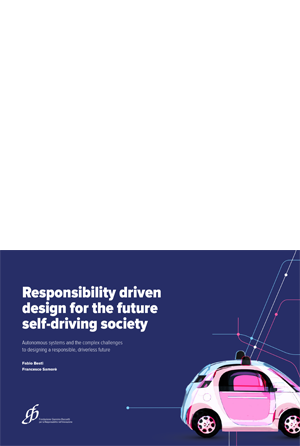Responsibility driven design for the future self-driving society is a white paper prepared by Fabio Besti and Francesco Samorè with contributions from Angela Simone and Jonathan Hankins, which analyzes advances in driverless technologies and investigates the possible impacts of this new technological phenomenon on the future society.
This work is the result of the collaboration between the Giannino Bassetti Foundation and the Design School of Politecnico di Milano, for whom Self Driving Society @2030, the Final Synthesis Laboratory of the Master in Integrated Product Design took place in November 2017, created and coordinated by prof. Giulio Ceppi.
Mobility automatization will not only have an impact on the transportation industry itself, it will lead to the transformation of the socio-cultural fabric of countries all over the world: habits and behaviour will change, new products and services will improve people’s lifestyles, cities will be reshaped and, above all, society will transform itself in its complexity.
The focus shifts from the self-driving car to the self-driving society, as Giulio Ceppi defined it in his university course.
On the one hand, this broader perspective allows stakeholders to identify a richer scenario for opportunities and innovation, while on the other it compels all actors to develop and better articulate discourse on the societal impact of this technological transformation; discourse that starts with governance and policy-making (to which the paper devotes an entire chapter) but is also able to involve all stakeholders touched by digital technology innovation, citizens included.
The white paper implicitly covers innovation opportunities and innovation responsibilities, the two main areas to emerge from the analysis of the self-driving society. How can these two (often but wrongly identified as opposite) aspects of innovation be integrated?
Building upon experience gained in the university, the work proposes the discipline of design and its methodologies as key tools to responsibly define and build a future society immersed in automated mobility systems. To support this proposition the paper presents some design tools that were specifically created for the university course, and showcases a selection of students’ projects that are particularly apt in describing the richness and value of what the authors define as a responsibility-driven design approach.
The white paper can be downloaded for free at this LINK, as well as the design tools discussed by the authors, available HERE.
TABLE OF CONTENTS
Introduction. The key role of responsibility for the self-driving society
1. Goal. Empowering the future stakeholders through vision and design thinking
2. Scenario. What will the future of autonomous mobility look like?
3. Responsibility topics in the field of autonomous transportation
4. Governance. Regulating a complex scenario
5. Workshop. Designing the Self-Driving Society of the future
Conclusions
Further reading and resources
The official presentation of this work took place on 9 May 2018 at Superstudio Più in Milan, within the Smart City: Materials, Technology and People exhibition promoted by Material ConneXion Italia. Some pictures below:
————

















